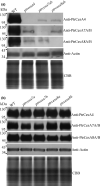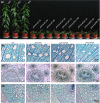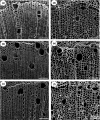Functional understanding of secondary cell wall cellulose synthases in Populus trichocarpa via the Cas9/gRNA-induced gene knockouts
- PMID: 33713445
- PMCID: PMC8362133
- DOI: 10.1111/nph.17338
Functional understanding of secondary cell wall cellulose synthases in Populus trichocarpa via the Cas9/gRNA-induced gene knockouts
Abstract
Plant cellulose is synthesized by a large plasma membrane-localized cellulose synthase (CesA) complex. However, an overall functional determination of secondary cell wall (SCW) CesAs is still lacking in trees, especially one based on gene knockouts. Here, the Cas9/gRNA-induced knockouts of PtrCesA4, 7A, 7B, 8A and 8B genes were produced in Populus trichocarpa. Based on anatomical, immunohistochemical and wood composition evidence, we gained a comprehensive understanding of five SCW PtrCesAs at the genetic level. Complete loss of PtrCesA4, 7A/B or 8A/B led to similar morphological abnormalities, indicating similar and nonredundant genetic functions. The absence of the gelatinous (G) layer, one-layer-walled fibres and a 90% decrease in cellulose in these mutant woods revealed that the three classes of SCW PtrCesAs are essential for multilayered SCW structure and wood G-fibre. In addition, the mutant primary and secondary phloem fibres lost the n(G + L)- and G-layers and retained the thicker S-layers (L, lignified; S, secondary). Together with polysaccharide immunolocalization data, these findings suggest differences in the role of SCW PtrCesAs-synthesized cellulose in wood and phloem fibre wall structures. Overall, this functional understanding of the SCW PtrCesAs provides further insights into the impact of lacking cellulose biosynthesis on growth, SCW, wood G-fibre and phloem fibre wall structures in the tree.
Keywords: Cas9; Populus trichocarpa; cellulose synthase (CesA); gRNA; gelatinous layer (G-layer); gene knockout; phloem fibre; secondary cell wall (SCW); tension wood.
© 2021 The Authors New Phytologist © 2021 New Phytologist Foundation.
Figures









Similar articles
-
Populus NST/SND orthologs are key regulators of secondary cell wall formation in wood fibers, phloem fibers and xylem ray parenchyma cells.Tree Physiol. 2019 Apr 1;39(4):514-525. doi: 10.1093/treephys/tpz004. Tree Physiol. 2019. PMID: 30806711
-
Involvement of CesA4, CesA7-A/B and CesA8-A/B in secondary wall formation in Populus trichocarpa wood.Tree Physiol. 2020 Jan 1;40(1):73-89. doi: 10.1093/treephys/tpz020. Tree Physiol. 2020. PMID: 31211386
-
Cellulose Synthase Stoichiometry in Aspen Differs from Arabidopsis and Norway Spruce.Plant Physiol. 2018 Jul;177(3):1096-1107. doi: 10.1104/pp.18.00394. Epub 2018 May 14. Plant Physiol. 2018. PMID: 29760198 Free PMC article.
-
The cell biology of secondary cell wall biosynthesis.Ann Bot. 2018 May 11;121(6):1107-1125. doi: 10.1093/aob/mcy005. Ann Bot. 2018. PMID: 29415210 Free PMC article. Review.
-
Wood cell walls: biosynthesis, developmental dynamics and their implications for wood properties.Curr Opin Plant Biol. 2008 Jun;11(3):293-300. doi: 10.1016/j.pbi.2008.03.003. Epub 2008 Apr 21. Curr Opin Plant Biol. 2008. PMID: 18434240 Review.
Cited by
-
Chromosome-scale genome assembly provides insights into the molecular mechanisms of tissue development of Populus wilsonii.Commun Biol. 2022 Oct 25;5(1):1125. doi: 10.1038/s42003-022-04106-0. Commun Biol. 2022. PMID: 36284165 Free PMC article.
-
Secondary cell wall patterning-connecting the dots, pits and helices.Open Biol. 2022 May;12(5):210208. doi: 10.1098/rsob.210208. Epub 2022 May 4. Open Biol. 2022. PMID: 35506204 Free PMC article.
-
Progress and challenges in applying CRISPR/Cas techniques to the genome editing of trees.For Res (Fayettev). 2022 May 11;2:6. doi: 10.48130/FR-2022-0006. eCollection 2022. For Res (Fayettev). 2022. PMID: 39525414 Free PMC article. Review.
-
Molecular understanding of wood formation in trees.For Res (Fayettev). 2022 Apr 25;2:5. doi: 10.48130/FR-2022-0005. eCollection 2022. For Res (Fayettev). 2022. PMID: 39525426 Free PMC article. Review.
-
Transcriptional landscape of highly lignified poplar stems at single-cell resolution.Genome Biol. 2021 Nov 22;22(1):319. doi: 10.1186/s13059-021-02537-2. Genome Biol. 2021. PMID: 34809675 Free PMC article.
References
-
- Abbas M, Peszlen I, Shi R, Kim H, Katahira R, Kafle K, Xiang Z, Huang X, Min D, Mohamadamin Met␣al. 2020. Involvement of CesA4, CesA7‐A/B and CesA8‐A/B in secondary wall formation in Populus trichocarpa wood. Tree Physiology 40: 73–89. - PubMed
-
- Atanassov I, Pittman J, Turner S. 2009. Elucidating the mechanisms of assembly and subunit interaction of the cellulose synthase complex of Arabidopsis secondary cell walls. Journal of Biological Chemistry 284: 3833–3841. - PubMed
-
- Barnett JR, Bonham VA. 2004. Cellulose microfibril angle in the cell wall of wood fibres. Biological Reviews 79: 461–472. - PubMed
Publication types
MeSH terms
Substances
LinkOut - more resources
Full Text Sources
Other Literature Sources

